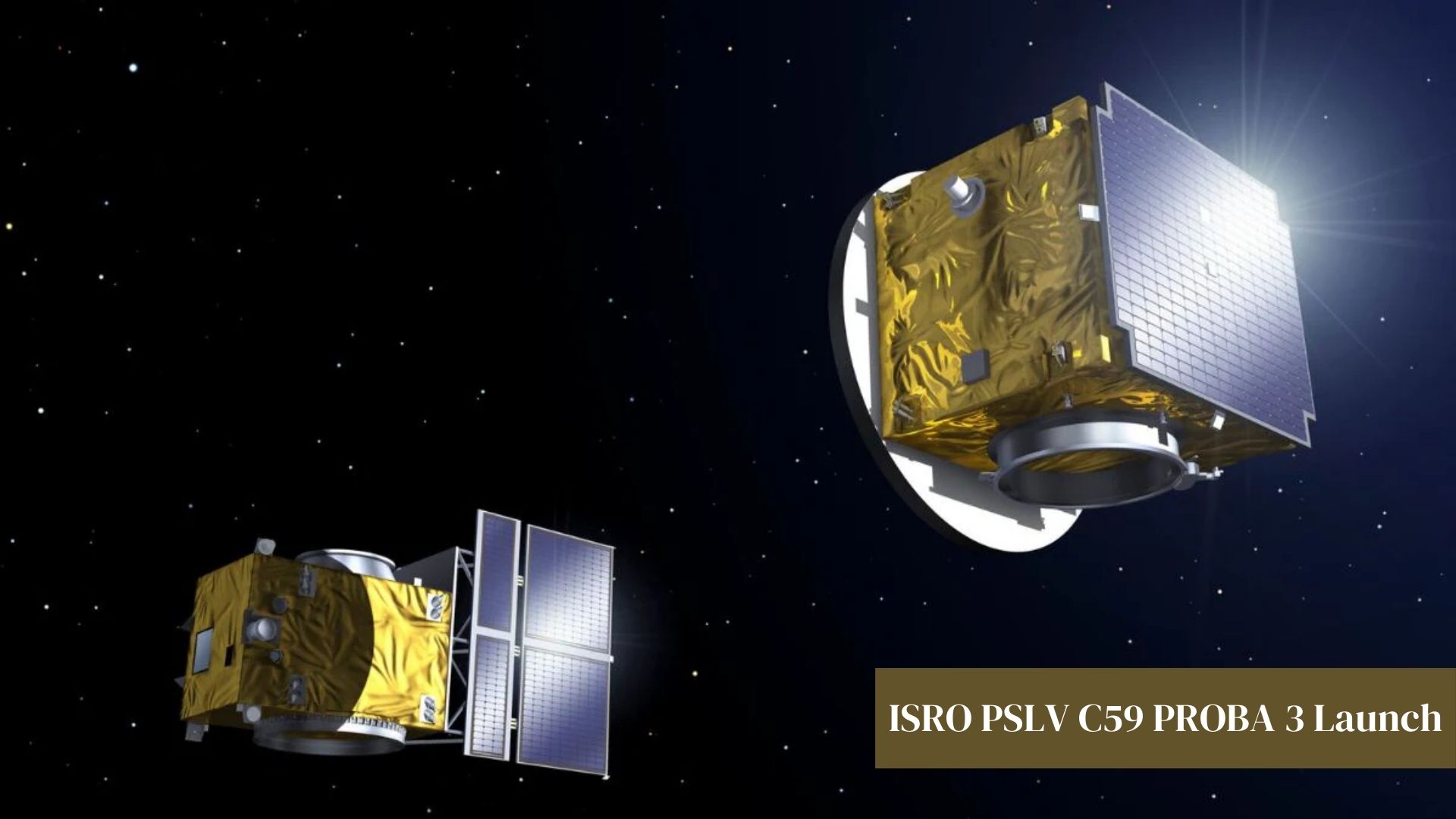The PSLV C59 PROBA 3 mission is a joint global effort showcasing spectacular integration of space technology. ISRO took a significant step forward in its space journey on 5th December 2024, when it launched the European Space Agency’s (ESA) PROBA-3 mission. The mission was undertaken from the Satish Dhawan Space Centre (SDSC-SHAR), Sriharikota, in collaboration with NewSpace India Limited (NSIL), a commercial subsidiary of ISRO.
This article focuses on the aspects of this unique mission, its relevance and its impact on the future of space ventures.
Mission Overview: PSLV-C59 and PROBA-3
This mission involved the Polar Satellite Launch Vehicle (PSLV), which is an important member of ISRO’s launch fleet. PSLV, which has been used to place satellites for communication, navigation, and earth observation due to its versatility and reliability, still remains at the forefront.
For the PSLV-C59 mission:
- Launch Vehicle: PSLV-C59
- Height: 44.5 meters
- Liftoff Mass: 320 tonnes
Stages: Four-stage propulsion system with six strap-on boosters (PSOM-XL configuration).
In this case, the launch demonstrated clear commercial objectives as it was an ESA undertaking where the objective was to place the PROBA 3 spacecraft into a high elliptical orbit.
What is PROBA 3?
The Project for On-Board Autonomy or PROBA 3 refers to an in-orbit demonstration (IOD) with remarkable developmental features, which is solely an ESA project. The mission is aimed at demonstrating an advanced technique of formation flying—creating dense formations of multiple satellites in orbit around the Earth.
Components of PROBA 3
PROBA 3 consists of two spacecraft launched together in a stacked configuration:
- Coronagraph Spacecraft (CSC): It uses a diaphragm to eliminate direct light in order to enhance observation of the sun’s corona.
- Occulter Spacecraft (OSC): It can position itself, relative to the coronagraph, at a distance, which allows it to create an artificial solar eclipse.
The focus of this study is to test a precise-relative positioning technology, which is necessary for the implemented satellite systems in future complex space operations.
Mission Objectives
The PSLV-C59/PROBA 3 mission had several objectives:
- Formation Flying Demonstration: To prove ESA can move satellites today using coordinated movements with precision in the sub-millimeter range.
- Solar Observation: With the coronagraph, PROBA 3 seeks to explore the solar corona in greater detail than has ever been possible before.
- Technology Validation: Validate that more advanced autonomous navigation, relative positioning, and formation control systems can be tested in orbit.
- Strengthening International Collaboration: Prove that ISRO can be trusted as a commercial satellite launching partner.
The Launch Event
The launch took off PSLV-C59 on December 5, 2024, at 16:04 IST. It was launched from the First Launch Pad (FLP) at SDSC-SHAR. In a couple of minutes the rocket brought the PROBA 3 spacecraft into the required elliptical orbit. It was in every detail a very normal mission for ISRO.
In the post-launch phase, operations included putting the satellites in the configuration they were designed to be in, so that the mission objectives could be achieved without any delays.
Significance of the PROBA 3 Mission
1. Advancing Space Science
The key focus in the PROBA 3 mission is on the corona, the atmospheric region of the Sun that is most important in the examination of its activity, solar wind, and other space weather phenomena. This information is important for the understanding of some events like geomagnetic storms that can be detrimental to satellite functioning and the power grids on Earth.
2. Formation Flying: A Revolutionary Technology
Incredible new vantage points open up for space exploration through the capability of flying two spacecraft in a precise formation. These include:
- Multi telescope systems in satellite astronomy multiple satellites.
- Multi-satellite observing earth from different angles.
- Satellite service and servicing implementing satellite missions.
3. Strengthening India’s Global Position
In terms of importance, for ISRO, the successful performance of a dedicated ESA mission enhances ISRO’s image as a trusted launch service client. It increases trade links and enhances the stature of India in the international space sector.
Technical Highlights of PSLV-C59
The PSLV-C59 mission incorporated cutting-edge technologies:
- Multi-Orbital Transfer: The payload is efficiently delivered to any orbital position because of the quad-segment propulsion system.
- Multisatellite Systems: India’s custom twin spacecraft design for PROBA satellite system.
- Satellite Control: Precision of satellite positioning obtained at the level of millimeters.
Collaborative Efforts Between ISRO and ESA
This mission is an example of multilateral planning at space level. If ISRO was in charge of operating activities, ESA was developing PROBA 3 and deploying the satellites. Such partnerships make it easy for countries to pool resources, leverage on knowledge and combine efforts into complex scientific problems.
Future Implications
The PSLV-C59/PROBA 3 mission serves its purpose to be the first of many that will progress onto even more complex satellite missions. Its success can potentially lead to:
- Advanced Formation Flying Missions: Useful in astronomy, navigation, as well as earth observation.
- Commercial Launch Opportunities: More International clients will be added to the NSIL portfolio.
- Joint Scientific Research: This will enhance cooperation amongst the different space agencies across the globe.
Challenges and Overcoming Them
While the mission was a success, the task of overcoming precision formation flying in space was quite challenging:
- Autonomous Control: Space crafts ought to maintain relative positions and orbit in three-dimensional space in the absence of any operator.
- Orbital Dynamics: It requires understanding the forces at play due to other masses in orbit around an elliptical path.
- Communication Latency: Making timely decisions when real-time space communication is impossible.
- With careful planning, thorough testing, and the development of unconventional ideas, ISRO and ESA met these hurdles.
A Milestone in India’s Space Journey
However, the PSLV-C59/PROBA 3 mission is more than achieving technical goals; it has further enhanced India’s position in space technology and international collaboration by showing joint capabilities. It further emphasizes the prospects of commercial space missions in order to scale and proceed further in the quest for exploration of space.
Conclusion
The PSLV-C59 launch with PROBA 3 showed how ISRO is capable of carrying out intricate missions and how ESA is able to perform innovative enhancement in space science. This mission not only improves solar research but also proves the concept of precision formation flying, a technique that will certainly play a major role in the future of space exploration.
With the spirit of partnership, ISRO strives for the next breakthrough, and the likes of PSLV-C59 serve as a testament to India’s place in the global space scene. Effective international collaborations underscore the achievements of PROBA 3’s ambitious objectives on space exploration being a global victory.

